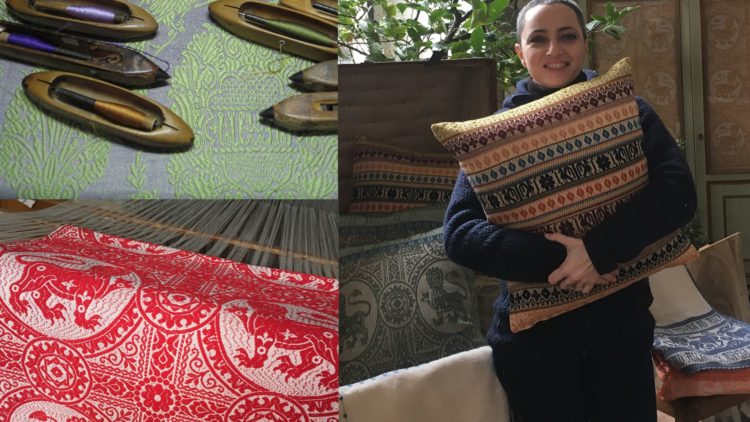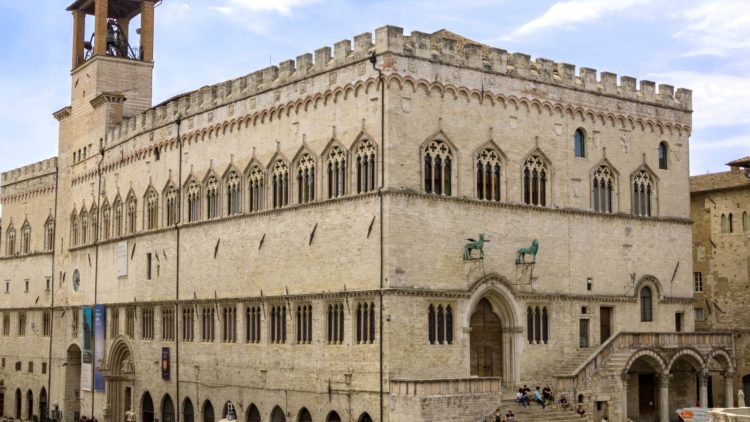Shopping in Perugia: Materia Ceramica

If you are shopping in Perugia, you’ll find a world of small shops and local restaurants on Via dei Priori in Perugia’s historic center. One of these, Materia Ceramica is the workshop of Maria Antonietta Taticchi, a ceramic artist who is also one of the street’s honorary guardians. In fact, as president of the neighborhood association, she has her own set of keys to the Torre degli Sciri. Maria Antonietta’s ceramics are meticulously hand-painted with scenes of Perugia, which she now calls home and of the Umbrian countryside where she grew up. If you stop by her studio you’ll often find her doing what she loves best—translating her life story onto the surface of hand-polished creations, which are made from the very soil that sustained her as a child.
Maria Antonietta’s artistic passion was born in her home, watching her paternal grandmother and her father paint. Then, when she was 16, her parents took her to the workshop of a master potter in Deruta—a town not far from Perugia whose sole industry is the production of Majolica pottery. The consequence of her visit: after high school, she chose to enroll in the “Pietro Vannucci” Academy of Fine Arts in Perugia; at this point, what other choice did she have? She’s been working as a “ceramista” ever since. Working alongside her these days is Caterina Aquinardi, one of Maria Antonietta’s six children, who inherited her mother’s love of ceramics and is carrying the Taticchi family talents into the next generation.

Maria Antonietta Taticchi and Caterina Aquinardi.
Photo Credit: Giancarlo Pastonchi
Maria Antonietta paints her landscapes with colors that evoke the environment, her homeland, and childhood memories—green and yellow symbolizing trees and fields, red symbolizing life and passion. In a recent conversation, she told me about her childhood in the countryside. She grew up in a large family of farmers, in a big house close to the Tiber River. Her grandfather Giuseppe, an agriculturalist, spent his life introducing innovative practices to Umbrian farming. “As a child, my grandfather made me observe the wheat fields and vineyards,” she said. Along the way he obviously instilled in her a love of the countryside and of nature’s delicate rhythms.

Photo Credit: Studio Metalli Panduri
Her ceramics are unique—different than the Majolica style. But Maria Antonietta sees her work as a part of the Umbrian cultural heritage, that is continually enriched thanks to ongoing research and innovation in the craft. She explained that she doesn’t use special colors, clay, glazes, or other tools that are not in the toolbox of other ceramic artists of the region. “I regard Deruta as my second home and consider myself lucky to have been able to meet the many craftsmen from whom I have gotten advice and help over the years,” she said. “With my ceramics, I’d like to transmit the ability to observe and see the beauty that surrounds us, attention to detail, going beyond the surface of objects, being able to set the imagination in motion.”
Her artistic process is multilayered, and every terracotta object is a one-of-a-kind piece. Before she decorates it, she usually polishes it, dusts it, and dips it in a white enamel bath (lead-free stanniferous paint). Once dried, she touches up the piece, then, carefully observes its shape to be inspired by it. She then paints her landscapes freehand, with spontaneity, using soft brushes to gradually layer the colors. The result: each piece has its own nuanced decoration.

Photo Credit: Studio Metalli Panduri
Maria Antonietta’s motifs will transport you through the winding streets of Perugia or into golden fields of Umbrian wheat. But her daughter Caterina brings another dimension to Materia Ceramica’s collection. She’s been working alongside her mother for six years. Though as a teenager, this wasn’t what she had imagined doing. She studied psychology at the University of Perugia, but a few exams before graduating she realized this wouldn’t be her path. “One day, I entered my mother’s shop and I asked her: “Mom, what if I also started making ceramics? But with my own style?” Since that day she’s been doing just that. Naturally, she learned from her mother. But she also attended courses in Deruta and studied design at the Pietro Vannucci Academy of Fine Arts.

Photo Credit: Archivio Materia Ceramica
Caterina told me her style is inspired more by geometry, but like her mother, she still takes inspiration from nature, from what surrounds her, and from the shape of the object she is going to paint. “Both in the decoration and in the combination of colors, I have certainly taken from my mother,” she says. “Working side by side, when I am in crisis, I always ask her for advice which then helps me to move forward.” Her style rendered on mugs and dinnerware is a fresh interpretation of traditional splatter ware and sponge painting. Her line of ceramic jewelry including necklaces, earrings, bowties, and cufflinks are made using various techniques (hand forming, slab, die extrusion). Then, they are decorated and assembled by hand.

Photo Credit: Archivio Materia Ceramica
Umbria is a region full of surprises. Art is everywhere. But since our tours, are all about wine and food, I couldn’t resist the chance to ask this mother and daughter team to tell us their favorite Umbrian dishes. Maria Antonietta: Lamb chops accompanied by a glass of Montefalco Rosso. Earthy, bold, and wild. Caterina: In summer, bruschetta with olive oil, fresh cherry tomatoes, very fresh mozzarella, and basil with a glass of Trebbiano white wine. Light, crisp, and mineral. Needless to say, whatever the meal, it is always served on beautifully handcrafted pottery.
Location: Via dei Priori, 70 – 06123 Perugia Italy
Opening Hours: Monday 4:30pm – 7:30pm
Tuesday to Saturday 10:00am – 1:00pm 4:30pm – 7:30pm
Contact: Maria Antonietta Taticchi/Caterina Aquinardi – info@materiaceramica.com
Shop Online: https://www.materiaceramica.com/
Telephone: +39 075 5730252
Mobile: +39 393 5145793
Read our blog posts
-
Giuditta Brozzetti Museum-Lab: Weaving Perugia’s Past & Present
Perugia’s Museum Workshop Giuditta Brozzetti (Il Museo-Laboratorio Giuditta Brozzetti) is about a 15-minute walk from Piazza IV Novembre. This hidden…
-
Palazzo dei Priori Perugia: Vices, Virtues and Mythical Beasts
In the showcase of architectural gems that grace the city of Perugia, Palazzo dei Priori, seat of the free commune…
-
Antica Spezieria Bavicchi: Stepping Back in Time at Perugia’s Oldest Spice Shop
Nestled among the ancient facades of Perugia’s historic center, the Antica Spezieria e Drogheria Bavicchi is a spice shop and…


